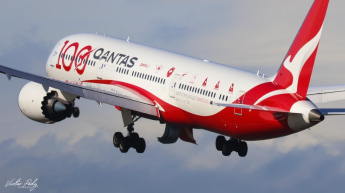
The US Marine Corps has embarked aboard ship the F-35B short takeoff and vertical landing (STOVL) version of the Joint Strike Fighter for its first operational employment.
The six F-35Bs of Fighter Attack Squadron (VMFA)121 embarked aboard the LHD USS Wasp in the East China Sea on March 5. The Wasp has been deployed to Sasebo in Japan to assume the role of flagship of the Wasp Expeditionary Strike Group (ESG) for a Western Pacific patrol, while VMFA-121 deployed to Marine Corps Air Station Iwakuni in Japan last year.
“This is a historic deployment,” Col. Tye R. Wallace, 31st Marine Expeditionary Unit (MEU) Commanding Officer said in a March 5 release.
“The F-35B is the most capable aircraft ever to support a Marine rifleman on the ground.”
Milestone for #NavyTheNationNeeds with a historic first: #F35B lands on #USSWasp, launching era of increased #USNavy–@USMC sea-based capabilities in Indo–Asian-Pacific – https://t.co/ba1ajyAZTQ pic.twitter.com/WMmSPHtMv5
— U.S. Navy (@USNavy) March 5, 2018
Retired USMC Lt Col David Berke, a former F-35B squadron commander and F-22 exchange pilot told Business Insider; “You’re about to put for the first time ever fifth-generation fighters on a ship at sea and put it into a highly contested area that is fraught with geopolitical risk and controversy and tensions.
“The implications of a fifth-generation aeroplane being in [the Pacific] is impossible to overstate. They’re going to provide capability that nobody knows exists yet.”
The USAF also has a squadron of F-35As currently deployed to Japan, while Japan itself is building its own F-35A capability.
















Paul
says:Great to see. Just hope it goes problem free!
Rob
says:Re “…..while Japan itself is building its own F-35A capability.”
Japanese government, in its latest drip-drip-drip info-feed on this, recently announced that their navy’s two Izumo-class ships were actually conceived, designed and built for prospective embarked F-35B ops, and that they are now officially considering buying them for the ships. This is on top their extant F-35A project.
The Japanese received F-35B ship-integration data during the design phase: required refit, including a ski-jump (the runway will run along the port-side overhang – that’s what it’s for – with the ski-jump roughly parallel to the forward (starboard) lift. By design the ships are optimised for 12 embarked F-35Bs, plus helos. This would entail a rotation between flight deck and hangar, although with a minimum/standard of six F-35Bs only one designated hangar spot will be needed: the remaining fix would be ranged aft.
Multiple reports out their from credible about this, so I’ll leave it to readers to hunt round for them. That said, someone very helpfully posted this Japanese news report online.
https://youtu.be/z02Wt9tipDc
BTW the South Koreans also recently noted their significant interest in refitting their flat-top Dokdo for F-35Bs.
Interesting times ahead!
Rob
says:Further to the above, USN and credible media report that USS Essex (LHD-2) has embarked F-35Bs for deployment. The LHD and her task group are doing extensive work-ups off the US west coast before deployment to Djibouti in June, when she’ll under CENTCOM’s umbrella in the 5th Fleet.
So, that’s two refitted 1990s LHDs doing the job.
BZ to all.
Myles Dobinson
says:Has anyone noticed what looks like a gun port on the right wing fairing? thought the B was having a podded gun pack?
PAUL
says:Note: The B model can only land vertically – not take-off vertically so operational STOVL capability only, not full VSTOL like the Harrier. .
Rob
says:Re comment by Paul “……The B model can only land vertically.”
Not quite. Not at all, in fact. F-35B pilots do conventional rolling landings all day, every day. They VL as required.
The British have spent much time and effort developing a technique called Shipborne Rolling Vertical Landing for their F-35Bs when landing on the new Queen Elizabeth-class carriers with high bring-bang loads. Approach speed relative to the deck at +/- 35 knots, with the roll from touchdown to stop between 200 and 300 feet, depending on the load and wind over deck. This is only possible for the QE carriers, as they have the necesaary beam.
BTW V/STOL is a long obsolete term. It’s STOVL, and nothing else. Been that way for decades.
Lastly, and with this readers will be pleased to note my exit, a quick look at credible Japanese media show that the Tokyo government will be making a binding, official announcement re the F-35B/Izumo-class towards the end of this year.
PAUL
says:Yes I know they can land normally, they can do a rolling short takeoff & landing & vertical landing but they cant take off vertically – There’s a good documentary on you tube which explains why during development & testing. Trying to takeoff vertically the F35B became too unstable
AlanH
says:Could this be why Australia’s two LHDs, HMAS Canberra and Adelaide, retained their ‘ski-jump’ as part of their design even though there was no immediate stated need for them?
Paul
says:Good point there Alan, but I don’t think we will be getting the B model!
Mick C
says:Alan and Paul , the Ski Ramp on the LHDs is part of the Hull unlike Ski Ramps on the Hermes & Invincibles which were bolted on to the Flight Deck.
This would mean a major redesign at great cost to get rid of something that does not impede the ships operation in any way and allows for a future change of policy regarding STOVL operations.
It simply come down to the cost of removal was not worth the expense.
Paul
says:The 4Th sqn will be based at Amberley. We won’t get the B model as I said. Cheers.
AlanH
says:With Defence acquisitions it’s best to never say “never”. Governments change.